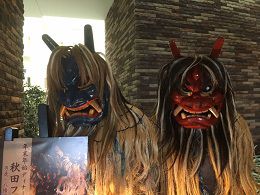Japanese traditional local events
In Japan, there are a great number of local traditional events held in towns and villages all over the country.The local cuisine and craft specialties are often used and help to make each of the events unique to the area.
If you are ever in Japan on holiday, we recommend that you research any local events that might be occurring near where you are traveling.
In this weekly Japanese language learner's blog, Japanese teacher Yuki Kamiyama introduces one of the local traditional events in Akita prefecture.
Read the blog and learn some new Japanese vocabulary. And watch the video to listen to fluently spoken Japanese.
ナマハゲ
Namahage

By KAMIYAMA Yuki

「ナマハゲ」は2018年にユネスコの無形文化遺産に登録されました。 秋田県の男鹿半島で行われれる伝統行事です。
日本ではとても有名で、秋田県と言えばナマハゲを思い浮かべる人も多いです。 ナマハゲは大晦日の夜に鬼のお面をつけ、ワラで作った衣装を着て、手には包丁を持って、家々をまわります。 「泣く子はいねえがあ(いないか)」「悪い子はいねえがあ(いないか)」と大きな声を出しながら家に入り、子どもたちのなまける心をいましめ、幸せをもたらします。 ナマハゲを迎える家は料理や酒でもてなします。 しかし最近は過疎化や高齢化がすすみ、ナマハゲをやる人がいないため続けるのが難しい地域もあるそうです。
秋田県だけでなく、日本にはこのようにお面をつけて厄を払い、幸せを願う伝統行事がたくさんあります。 日本に来たときには、有名なお祭りだけではなく、地域の伝統行事もぜひ楽しんでみてください。
To listen to this blog, please watch our Youtube video.
ナマハゲ
「ナマハゲ」は2018年(ねん)にユネスコの無形文化遺産(むけいぶんかいさん)に登録(とうろく)されました。 秋田県(あきたけん)の男鹿半島(おがはんとう)で行(おこな)われれる伝統(でんとう)行事(ぎょうじ)です。
日本(にほん)ではとても有名(ゆうめい)で、秋田県(あきたけん)と言(い) えばナマハゲを思い浮かべる(おもいうかべる)人(ひと)も多(おお)いです。 ナマハゲは大晦日(おおみそか)の夜(よる)に鬼(おに)のお面(めん)をつけ、ワラで作(つく)った衣装(いしょう)を着(き)て、手(て)には包丁 (ほうちょう)を持(も)って、家々(いえいえ)をまわります。 「泣(な)く子(こ)はいねえがあ(いないか)」「悪(わる)い子(こ)はいねえがあ(いないか)」と大(おお)きな声(こえ)を出(だ)しながら家(いえ) に入(はい)り、子(こ)どもたちのなまける心(こころ)をいましめ、幸(しあわ)せをもたらします。 ナマハゲを迎(むか)える家(いえ)は料理(りょうり)や酒(さけ)でもてなします。 しかし最近(さいきん)は過疎化(かそか)や高齢化(こうれいか)がすすみ、ナマハゲをやる人(ひと)がいないため続(つづ)けるのが難(むず)しい地域 (ちいき)もあるそうです。
秋田県(あきたけん)だけでなく、日本(にほん)にはこのようにお面(めん) をつけて厄(やく)を払(はら)い、幸(しあわ)せを願(ねが)う伝統(でんとう)行事(ぎょうじ)がたくさんあります。 日本(にほん)に来(き)たときには、有名(ゆうめい)なお祭(まつ)りだけではなく、地域(ちいき)の伝統(でんとう)行事(ぎょうじ)もぜひ楽(たの) しんでみてください。
Namahage
In 2018 'Namahage' was registered as a UNESCO Intangible Cultural Heritage. It is a traditional event that takes place in Oga Peninsula in Akita Prefecture.
It is very famous in Japan, and when you mention Akita Prefecture, then for a lot of people, 'Namahage' comes to mind. A 'Namahage' puts on a demon mask, wears some straw clothes, and holds a knife in one hand and goes from house to house. He enters each house shouting, “Are there any crying children here?” or “Are there any bad children in this house?” and admonishes children's laziness and brings happiness.
At the houses where 'Namahage' visits he receives a warm welcome of food and alcohol. But recently, due to depopulation and the aging society, there are no people who dress up as 'Namahage' and there are some areas where it is becoming difficult to continue the tradition.
It is not only in Akita Prefecture but all over Japan, there are many traditional events in which people put on masks and drive off bad luck and welcome happiness. When you come to Japan, please try to visit these local events as well as some of the more famous festivals.
無形文化遺産(むけいぶんかいさん)Intangible Cultural Heritage
大晦日(おおみそか)New Year's Eve
お面(おめん)をかぶる wear a mask
ワラ(わら)straw
なまける be lazy
いましめる admonish
もたらす bring
もてなす warm welcome
過疎化(かそか)depopulation
厄を払う(やくをはらう)drive off bad luck
Hajimemashite, my name is Yuki Kamiyama. I live in Tokyo with my family (husband and two children).
My hobbies are reading books and watching movies. It doesn't matter what genre, I really enjoy and get stimulated by coming into contact with worlds that I do not yet know.
Why did you decide to study Japanese ? Was it for work, or for a hobby ? Or was it travel to Japan ? I would like to stand beside you and help you realize your hopes as you state, “I want to say this in Japanese ! I want to learn !” I will support you as much as I possibly can to get you to achieve your goals.
